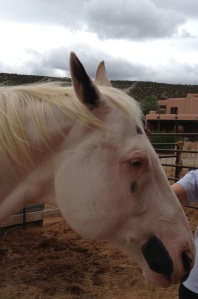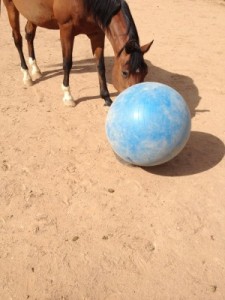Recently I had a client horse who broke his jaw. This is how it happened: he was clenching his teeth around a bar of his stall door, while his forefeet were on a ledge of that same door. He dropped one foot down and neglected to release his teeth from the bar of the stall. This action broke his jaw on the side of the mandible.

Jaw fractures are fairly common in horses. They can get kicked in the jaw, or get in trailer accidents or do this very same thing of not letting go. Some horses that are very oral will do this more frequently, hang on to something with their teeth like their life depends on it. Horses do all sorts of things in the pasture and we don’t know how they manage to do them: get cast in fences, kicked, foals get stuck in water troughs, you name it. A friend of mine once referred to this as “the Kamikaze behavior of horses.” Horses are not quite like the Japanese suicide mission pilots of World War II because they don’t plan to do themselves in for a badge of honor, but their flight/fright mechanism is so strong it often appears as though they are on a mission to self-destruct. In bodywork and in training, we want to diminish the flight/fright response so that we don’t have a dangerous horse that over-reacts or gets himself into trouble.
Just like you baby-proof a house for toddlers, you need to horse-proof your horse facilities; yet some horses still manage to find the one place to get into trouble.
This particular horse is a little accident prone. He is very fun loving and a good performance horse but gets himself into trouble sometimes with his antics. I remember when I first got my gelding Khami years ago, he had cut open his chest on some barbed wire. I think he was lonely because his pasture mate had gone off to compete in the Tevis Cup. When I picked him up from his previous owner, he was a mess. A week later, he got a branch stuck up his nose and had to have it surgically removed. It went on like that for awhile.
I had worked with this client horse pre-accident on softening and releasing the poll, which was jammed up between his ears. I feel this affected his thinking processes. Leta Worthington, local Animal Communicator, said he indicated to her that he had headaches. She prescribed a remedy that helped this condition before I saw him the first time. By the time he broke his jaw, I’d gotten the poll and neck much softer. My work had to begin again after the accident since the poll, neck and spine got very jammed from the break. The swelling in his mandible was also so great that it put pressure across his entire face and frontal lobe as well. After two sessions post-accident, his poll is much more comfortable and the swelling has reduced considerably. It’s rather inconvenient to put an ice pack on a horse’s face during recovery. Ortho-Bionomy can be very effective in reducing swelling right away.
The accident had also had a domino effect down the spinal column so that when the head was injured, the impact traveled down the spine to the sacrum, which was out of alignment. This had created an overall stiffness in the horse which I could address with bodywork.

The mouth itself is healing very nicely and this injury will take four to six weeks to heal. This is a case where the vet will monitor the mouth and the stitches and all his efforts, but the overall affect of the fracture on the body is not addressed by veterinary medicine. This is something we see all the time with people as well. Injuries throw our bodies out of alignment and balance but can be addressed very well with Ortho-Bionomy. There is much more than meets the eye (or the untrained eye) after a wound has been successfully sewn up, or an injury appears to be healing. Getting a “clean bill of health” often does not factor in underlying, ongoing issues.
Horses that tend to be accident prone can benefit greatly from bodywork and possibly some homeopathics or other remedies. Some shift needs to take place so they can still have fun and satisfy their curiosity without damaging themselves in the process. They also can benefit from ground games such as playing with a horse ball or cones, liberty work over poles, whatever appeals to them.
An interesting article in Horse.com:
Repairing Jaw Fractures in the Field
Services: Bodywork (Ortho-Bionomy for people, Equine Positional Release/Equine Ortho-Bionomy): private sessions, tutorials, phone consultations, distance healing and gift certificates
Liberty Training: clinics, mini-clinics, workshops, private and semi-private sessions, tutorials, consultations: by appointment: 505.501.2478 or emailing susansmith@orthohorse.info
Looking forward to fall Liberty Training mini-clinics – work for two-three hours with two-three people and horses. Tell a friend and get to experience liberty work together! Dates: September 8, October 5, November 9. Contact me for details.
Liberty Foundations Waterhole Rituals Equine Clinic at Spirit Horse Ranch near Oklahoma City, co-teaching: Ruella Yates, Certified Carolyn Resnick Trainer and Susan Smith, Suggested CR Trainer. Liberty Horse Training. September 28-29, 2013. Contact Ruella Yates at ruella@libertyfoundations.com, or 405-771-4274. Susan will be giving a three-hour tutorial on her OrthoHorse bodywork for a limited number of students. Call 505-501-2478 or email susansmith@orthohorse.info for details.




Horse-proofing a pasture is a constant work in progress! Curious horses can get themselves into odd predicaments! Enjoyed and learned from this post, Susan, as usual!
Thanks, Ruella. I sure don’t know how it’s fully possible to “horse-proof” a pasture or any space – as horses seem to find things we can’t imagine! It’s that super curiosity they have.